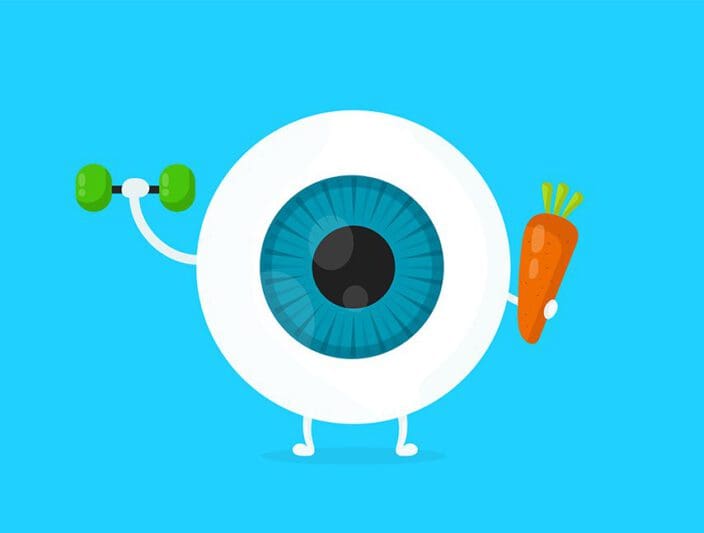Eye Exercises for Presbyopia: Waste of Time or Not?
Home / Farsightedness (Presbyopia) /
Last Updated:
There are numerous eye exercises on the market that claim to act as a “cure” for aging eyes, or presbyopia. As you get older, your eyes will naturally undergo several changes, just as the rest of your body does, and it can become difficult to see things clearly up close and to read without eye strain or difficulties.
Table of Contents
The National Eye Institute reports that anyone over the age of 35 is vulnerable to presbyopia, which occurs as the lens of the eye hardens and is less flexible than it is during younger ages. The muscles that help to reshape the lens to constrict and focus on things up close also do not work as well in older age, and this can contribute to blurry up-close vision.
At this point there are no specific eye exercises that have been proven to change the shape, structure, or workings of the eye to treat or minimize presbyopia. There are some exercises that can help to train your brain, however, that can then improve perceptual learning and therefore help with farsightedness, reading, and vision. In this way, eye exercises may be able to help improve presbyopia or even delay its onset.
Presbyopia is a progressive refractive error that nearly everyone will suffer from at some point. While you may be able help your farsightedness some, most doctors recommend treating it with corrective eyewear or laser surgery.
Presbyopia Eye Exercises Explained

Farsightedness occurs when light that is supposed to be focused on the retina is focused behind it instead. It is often related to the eyeball being too short or the cornea not steep enough. In the case of presbyopia, farsightedness is related to the lens becoming less flexible and less able to constrict over the cornea to focus on close objects.
Eye exercises are marketed that claim to improve vision by making changes to the eyes. It’s important to understand that most refractive errors are the cause of the shape of the cornea, which cannot be improved through any type of exercise. What you may be able to do is improve eye health and flexibility by exercising your eyes in such a way to keep them working optimally for longer. You will not be able to keep presbyopia from happening altogether, but you may be able to delay it some.
You deserve clear vision. We can help.
With 135+ locations and over 2.5 million procedures performed, our board-certified eye surgeons deliver results you can trust.
Your journey to better vision starts here.
Many eye exercises have you focus on certain things for a set time. They may have you look at lines of big text alternating with lines of smaller text to improve clarity. Some have you intentionally look at blurry text or images and then shaper ones with the idea being that your eyes will improve the image the second time around. There are no eye exercises like this that are recommended by doctors, however, and a lot of them are expensive and may not have the desired results.
What The New York Times reports may actually help with minimizing or delaying presbyopia is retraining your brain. By improving perceptual learning, you may be able to read better and focus more clearly on those close images and objects for longer than you would have before. These exercises involve focusing on a Gabor patch, which uses contrast to stimulate the part of your brain that deals with vision abilities.

How Eye Exercises for Presbyopia Can Help
Perceptual learning exercises serve to change the way your brain processes visual stimuli, which can in turn improve reading speed, accuracy, and even clarity. When you read something, your brain works to understand and process what it is seeing. Low contrast, small fonts, and crowded images can make it hard to process what you are seeing and may contribute to blurry vision. If you can improve how quickly and accurately you can process what you are seeing, you may then be able to comprehend what you are seeing faster and with more clarity.
Studies, like the one published in Vision Research, show that by using Gabor patches to improve contrast sensitivity, processing speed can be improved and with it blurry vision. Doing these exercises for several minutes a few times a week for months can help with perceptual learning to improve vision. The Journal of Vision explains that spatial crowding or clutter, as is the case with small fonts, can be a factor in blurry vision and that by improving how you process these things, you can actually improve presbyopia and the ability read and discern things up close.
While your eye itself cannot be changed specifically with eye exercises to minimize or prevent presbyopia, your brain is relatively elastic and can be retrained in how it sees things. The journal Scientific Reports publishes that people struggling with presbyopia have poor contrast sensitivity, and this is related to how neural responses are processed in the visual cortex region of the brain. When these functions become sluggish with age, it can be harder to recognize objects and letters as quickly, contributing to blurry vision.
Regularly practicing exercises, which involve looking at Gabor patches placed strategically to improve contrast sensitivity and processing speed, has been shown to potentially help with presbyopia symptoms and vision acuity. Perceptual learning exercises may then be able to retrain the part of your brain that is involved with vision. They could therefore improve presbyopia and restore age-related vision decline at least partially, the journal Psychological Science reports.
Other things can contribute to keeping your eyes young and healthy.

- Eat balanced meals.
- Drink plenty of water on a regular basis.
- Protect your eyes from the sun.
- Take breaks from looking at things up close.
- Stop reading or straining your eyes when you are tired.
Presbyopia impacts most of society by middle age and cannot be prevented indefinitely. Reading glasses, prescription glasses, or contacts are often needed to treat moderate to severe presbyopia, and corrective laser eye surgery is an option as well.
There are some exercises you can do to try to minimize or improve presbyopia, but they are often tedious and time-consuming. Treatment for the refractive error in the form of surgery or corrective eyewear is most effective.
Treating Presbyopia
Presbyopia has multiple treatment options, such as eyewear that helps bring nearby objects into focus, enabling you to see things clearly. The main presbyopia therapies include:
Eyeglasses
Options include bifocals that remedy close-up and distance vision issues, trifocals that fix near, mid-range, and far vision, and progressive lenses for distance, mid-range, and close-up vision therapy.
Contact Lenses
If you’d rather not wear eyeglasses, consider mono-vision or multifocal contact lenses instead. These can correct focusing problems and help you read better.
Surgery
One option for you is refractive surgery, in which the cornea’s shape is altered to correct far and near vision problems. A corneal implant can also correct your eye’s focusing power.
You deserve clear vision. We can help.
With 135+ locations and over 2.5 million procedures performed, our board-certified eye surgeons deliver results you can trust.
Your journey to better vision starts here.
References
- Facts About Presbyopia. (October 2010). National Eye Institute.
- Making Perceptual Learning Practical to Improve Visual Functions. (October 2009). Vision Research
- Training on Spatiotemporal Masking Improves Crowded and Uncrowded Visual Acuity. (2015). Journal of Vision.
- Training the Brain to Overcome the Effect of Aging on the Human Eye. (February 2012). Scientific Reports.
- Improving Vision Among Older Adults. Behavioral Training to Improve Sight. (March 2015). Psychological Science.
- Presbyopia Treatment. (January 13, 2020). American Academy of Ophthalmology.
This content is for informational purposes only. It may have been reviewed by a licensed physician, but is not intended to serve as a substitute for professional medical advice. Always consult your healthcare provider with any health concerns. For more, read our Privacy Policy and Editorial Policy.
